Epiphytes: Plants Of The Enchanted Forest Canopy
First published in Sanctuary Asia,
Vol. 42
No. 2,
February 2022
By Dr. Seshadri K.S.
If there is one sight that accurately describes the euphoria of being in a tropical, evergreen forest, it is that of a canopy towering overhead, supported by tall trees with large buttresses. If we braved the hordes of leeches and ticks and went one step further and craned our necks upward, we would find that the treetops can be replete with colourful, flowering plants. Many of these plants are not rooted to the ground and grow exclusively in the treetops. We would then certainly rue the fact that the life flourishing in the enchanted canopy is ever so slightly out of reach.
While a pair of binoculars can help us get a closer look at the canopy and its myriad denizens, there is nothing like being among them and seeing them at eye level. Unfortunately, I was painfully aware of this, having grown up in a city and never having climbed a tree – a fact that I had conveniently forgotten when I enthusiastically agreed to study epiphytic plants in the forest canopy. To do so required climbing trees but this did not dim my excitement as I set off in a rickety old bus to the southern tip of the Western Ghats and up the undulating hills of the Kalakad-Mundanthurai Tiger Reserve (KMTR) in Tamil Nadu, where I would spend the next two years metaphorically swinging from the treetops.
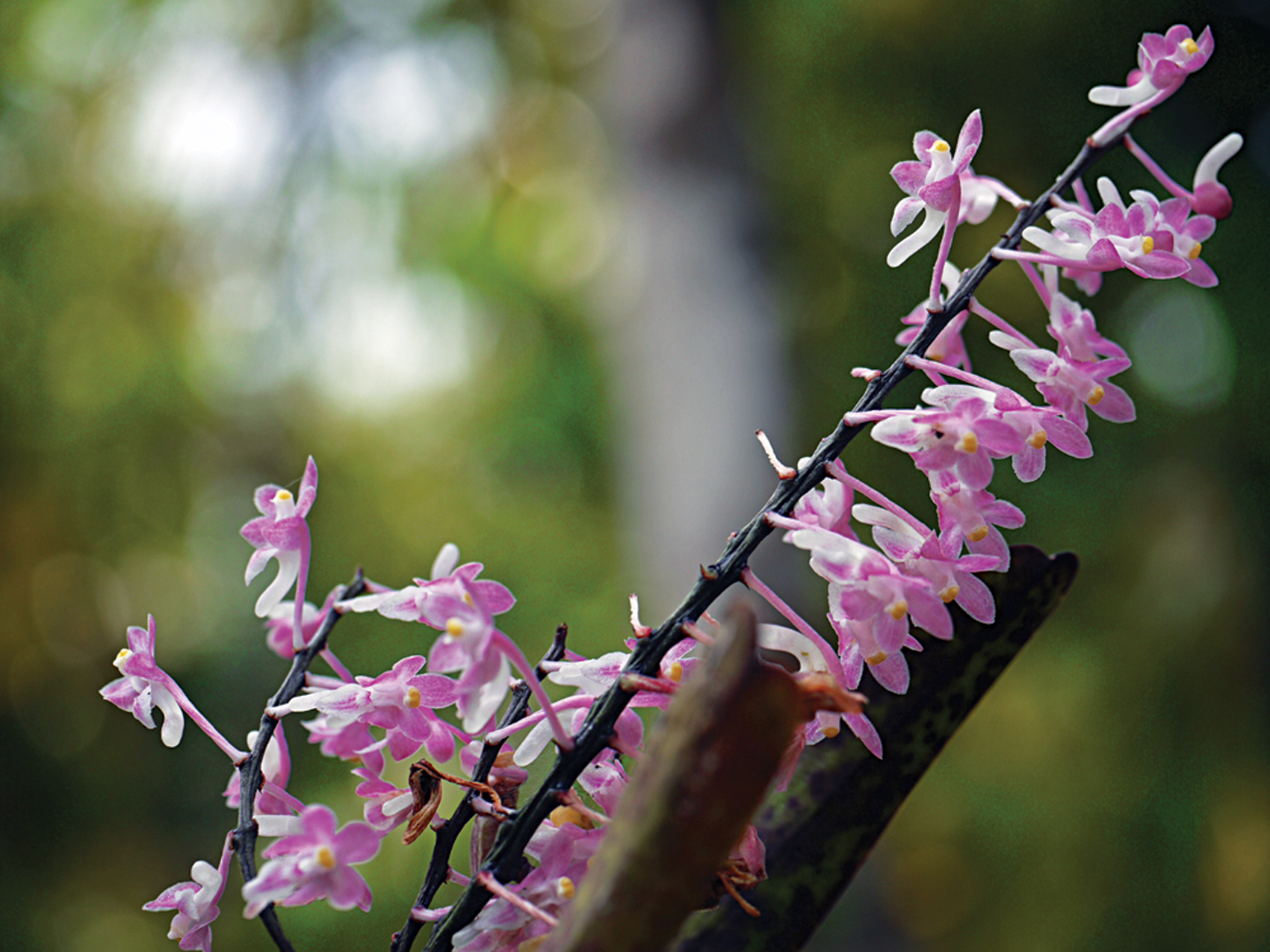
Orchids are epiphytic plants that have adapted well to survive in the harsh forest canopy. Of the epiphytes encountered by the author and his colleagues, 85 per cent were orchids like this Aerides ringens (Lindl.) Fischer, an endemic orchid of the Western Ghats. Photo: Public Domain/Dinesh Valke.
Why We Should Care About Epiphytes…
An aggregate of all tree crowns in a forest is the forest canopy and it is often dubbed as the eighth continent. It is the first layer of vegetation that interacts with the atmosphere and is responsible for several functional aspects of the ecosystem such as gaseous as well as moisture exchange. In this mystical, three-dimensional world, nearly 40 m. above the ground, everything from a tiny invertebrate to a large mammal thrives. Plants are among the most diverse groups of organisms found in the forest canopy. Epiphytes are non-parasitic plants that germinate and grow on other plants. Currently, over 31,000 species of epiphytes are known globally and comprise nearly 10 percent of plant diversity. They are particularly diverse in parts of central, south America, south and, southeast Asia but very little is known about them.
Epiphytes are not only beautiful but are a critical component of the forest canopy ecology and have unique adaptations. In a tall forest, little sunlight reaches the ground, and this is possibly why epiphytes flourish in the canopy, where there is ample sunlight. Growing away from soil would mean that there is little access to nutrients. Being on the treetop, they are also at the mercy of the weather’s vagaries. When the rains pour, the water drips down the tree and very little gets retained. When the sun shines, it can scorch the branch and everything that grows on it. Epiphytes have overcome this challenge by evolving a specialised physiology and morphology. Their roots can absorb nutrients from the atmosphere with the help of moisture, either in the form of incessant rain or mist. Some epiphytic plants have thick, leathery leaves to conserve water, like desert plants. Because they grow in nutrient-poor environments, they likely benefit from the presence of moss, which acts as a sponge, holding water. They germinate either as dense clusters or spread individually along branches, trapping any debris from the canopy. The rich debris, comprising flowers, fruits, animal feces as well as other decaying matter, form what is termed as ‘canopy soil organic matter,’ which nourishes the epiphyte, apart from being an important refuge to several invertebrates.
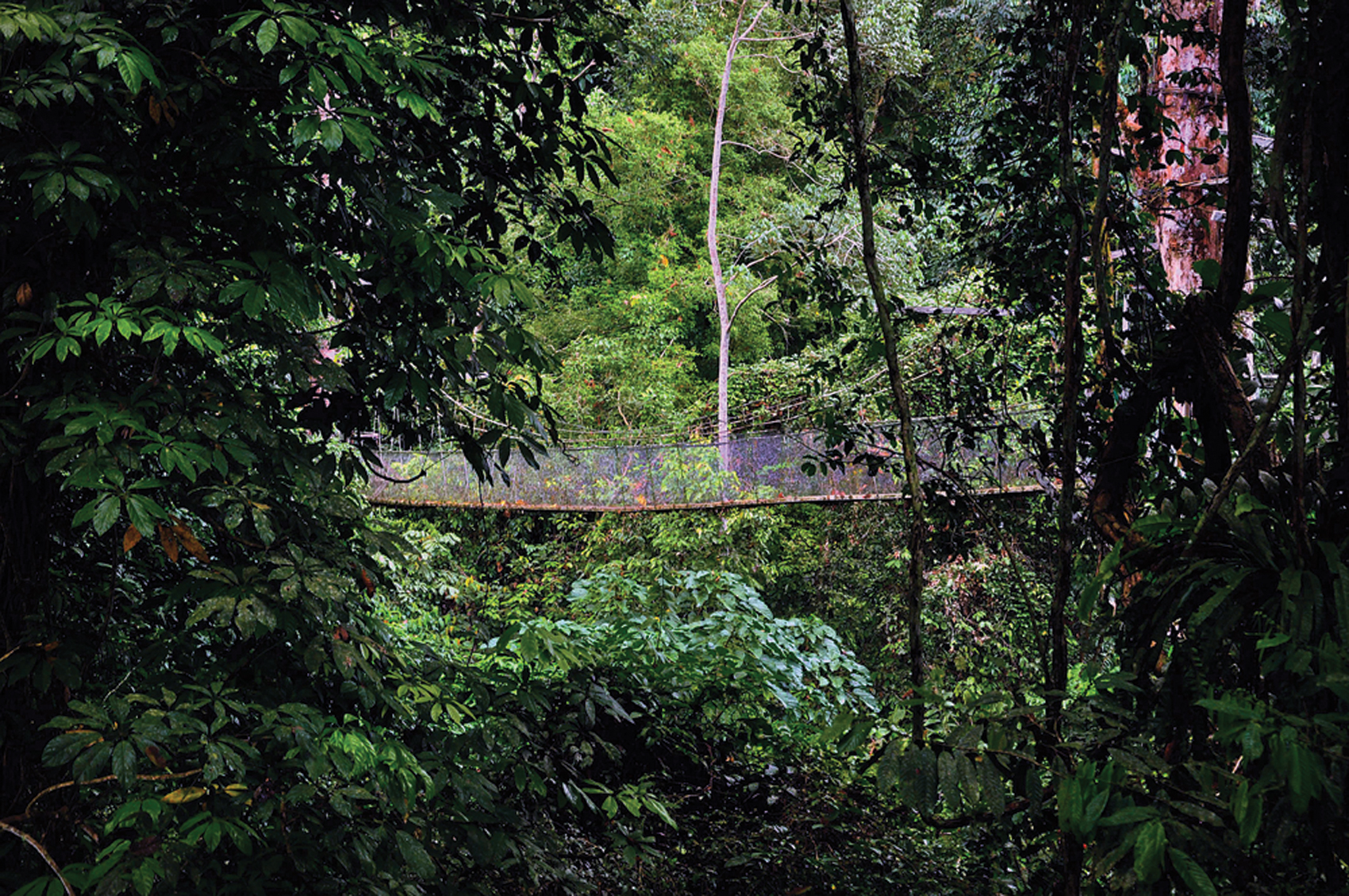
A canopy walkway in the Kalakad Mundanthurai Tiger Reserve (KMTR) in Tamil Nadu. Photo: Dr. Seshadri K.S.
Climbing Trees
Studying the forest canopy from the ground is challenging and until recently, our knowledge about the canopy was limited to observing fallen trees or branches or relying on the skill of trained monkeys to bring down specific plants. Technological advancements in the last four decades have taken the field of canopy ecology forward to a great extent. Researchers have used anything from a good old ladder, cherry pickers, hot air balloons and ropes to ascend to the canopy and observe, document, and try to understand this amazing, fragile ecosystem.
I vividly remember the first time I climbed up a 32 m. tall Cullenia exarillata tree using ropes. Tamizalagan, our assistant and colleague deftly rigged up the ropes. I noticed a wooden ladder nailed to the tree, which I was told was about 15 years old and was used by my advisor, Dr. Soubadra Devy from the Ashoka Trust for Research in Ecology and the Environment (ATREE). Dr. Soubadra pioneered the study of forest canopies by climbing trees and studying plant pollination biology, often risking life and limb to climb up before sunrise to get there before pollinators visited, to better identify them. It was only many years later that her team began using the single rope technique that I was hoping to master over a couple of weeks.
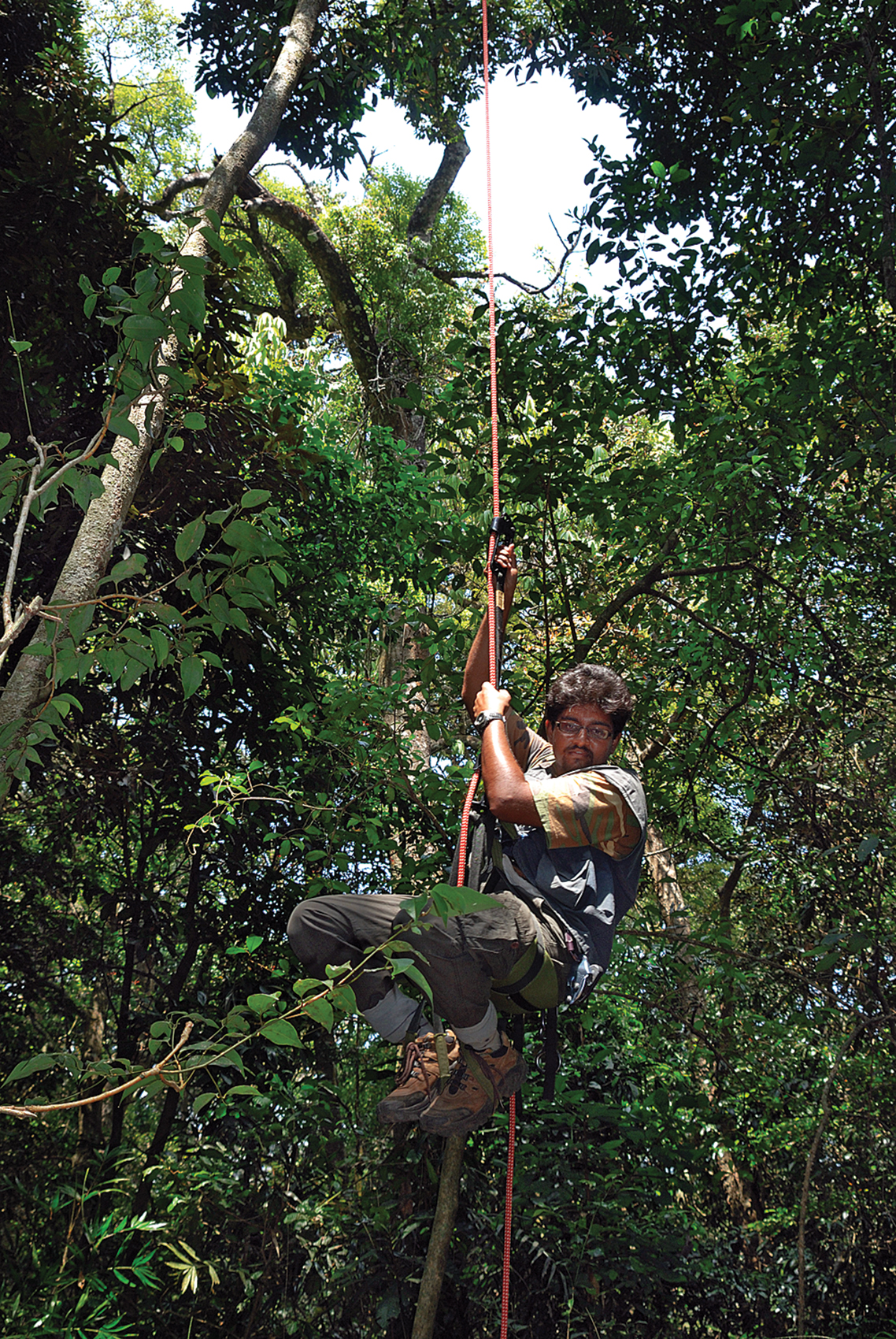
The author descends from a tree, using the single rope technique. Pioneered by Dr. Donald Perry in the late 1960s, this technique has enabled hundreds of researchers to go up into the canopy safely. Photo: Dr. Seshadri K.S.
Rigging the tree was not an easy task. We would begin by finding a suitable tree, devoid of any visible damage to the crown. Using a large-sized metal nut tied to a fishing line, we used a powerful catapult to shoot the line over a limb. The nut would sometimes get entangled in the vegetation and we would then have to cut the line and begin the process all over again. Or the catapult would snap, having been cut a thousand times by the zipping fishing line. If the line got over the branch without trouble, we would haul back and forth a nylon thread, then a parachute cord, and finally a solid core climbing rope over the branch and secure one end with specific knots and hitches. The free end of the rope would then be used to ascend using two ‘jumar’ ascenders – devices that cling onto the rope and move only in one direction. The ascenders (chest and leg) were secured to a harness we wore, and we would inch up the rope by sitting and standing alternately. Descending from the tree was exhilarating as we used a different friction-controlled device called the ‘8’ (named after its shape) and pushed off a branch. Once down, we would spend at least an hour packing up and lugging the rope back a few kilometres to the road where we would catch a bus back to our temporary residence. Fortunately, the bus would often be late but never earlier than when it was supposed to be there.
Going up the tree had been made easier for this city slicker with the single rope technique, pioneered by Dr. Donald Perry in the late 1960s. It has enabled hundreds of researchers to go up into the canopy safely. Using this technique, one can keep away from the main trunk, explore along the way up, and once in the crown, move laterally, safely secured to a branch using lanyards. Once I got the hang of the ropes, the next big challenge for me was to begin to study the epiphytes.
Epiphytes and their Ecosysem Function
Orchids are a large group of epiphytic plants, possibly the most well-known and documented. They have several adaptations to survive in the harsh canopy. Orchid flowers are renowned for their beauty and have co-evolved with pollinators such as bees. They have complex mechanisms, including visual and chemical cues to fool unsuspecting insects and force pollen on them. When the insect visits another flower of the same orchid species, it then pollinates it. During particularly dry periods, they can slow down their metabolism and appear dead but with the arrival of the monsoon, they spring back to life, putting out fresh leaves and flowers. Many other epiphytes such as bromeliads, found in central and south America, hold water-forming ‘phytotelmata’ which host an incredible diversity of life, from mosquitoes to amphibians.
Many epiphytes also have a distinct distribution within the canopy. While some are exclusive to the outer crown of the tree, some can be found only near the trunk and may even be stratified vertically. Some prefer to grow on one tree species over others. Many produce small spores, which are dispersed by wind, or larger seeds, which are dispersed by animals. Why and how they colonise the microhabitats within the canopy is still an emerging arm of research in canopy ecology and it is particularly relevant to understand how they would respond to anthropogenic changes.
The Lasting Impact Of Logging
The forests of KMTR had been selectively logged for timber over several years until logging activity ceased four decades ago. The forests have since been largely protected and allowed to recover. We were hoping to examine how the logging activities had impacted the epiphyte community. Because epiphytes appear to have specific associations with the host tree, light irradiance, and wind, we expected the logged forests to have an altered epiphyte community.
Of course, we could not go back in time to document the epiphyte community before logging and evaluate what had happened since. We could, however, find an undisturbed forest patch with similar characteristics to the logged sites. Over the next two years, we climbed 200 trees, 100 each in the logged and unlogged forest, and counted epiphytes on branches. We also measured nearly 20 different parameters of the host tree as well as those of epiphytes.
We found 2,129 individuals of epiphytes belonging to 20 species, growing on 173 host trees belonging to 22 species in the study. Orchids were the most dominant epiphytes, comprising 85 per cent of the species encountered. Among the 20 species, six of them were endemic to the Western Ghats and the rest were either widespread in India or into parts of Southeast Asia. We found a greater abundance as well as diversity of epiphytes in the logged forest, but the species composition remained similar. It appeared that the logging activity somehow altered the conditions in the canopy enabling the epiphytes to flourish and colonise the vegetation. This seems logical as the logging activity would have created gaps in the canopy, increasing light irradiance and wind flow. One would need to examine the spore or seed arrival rates in the two forest stands to confirm an increase in their dispersal or the arrival of spores on branches that had conditions favourable for germination.
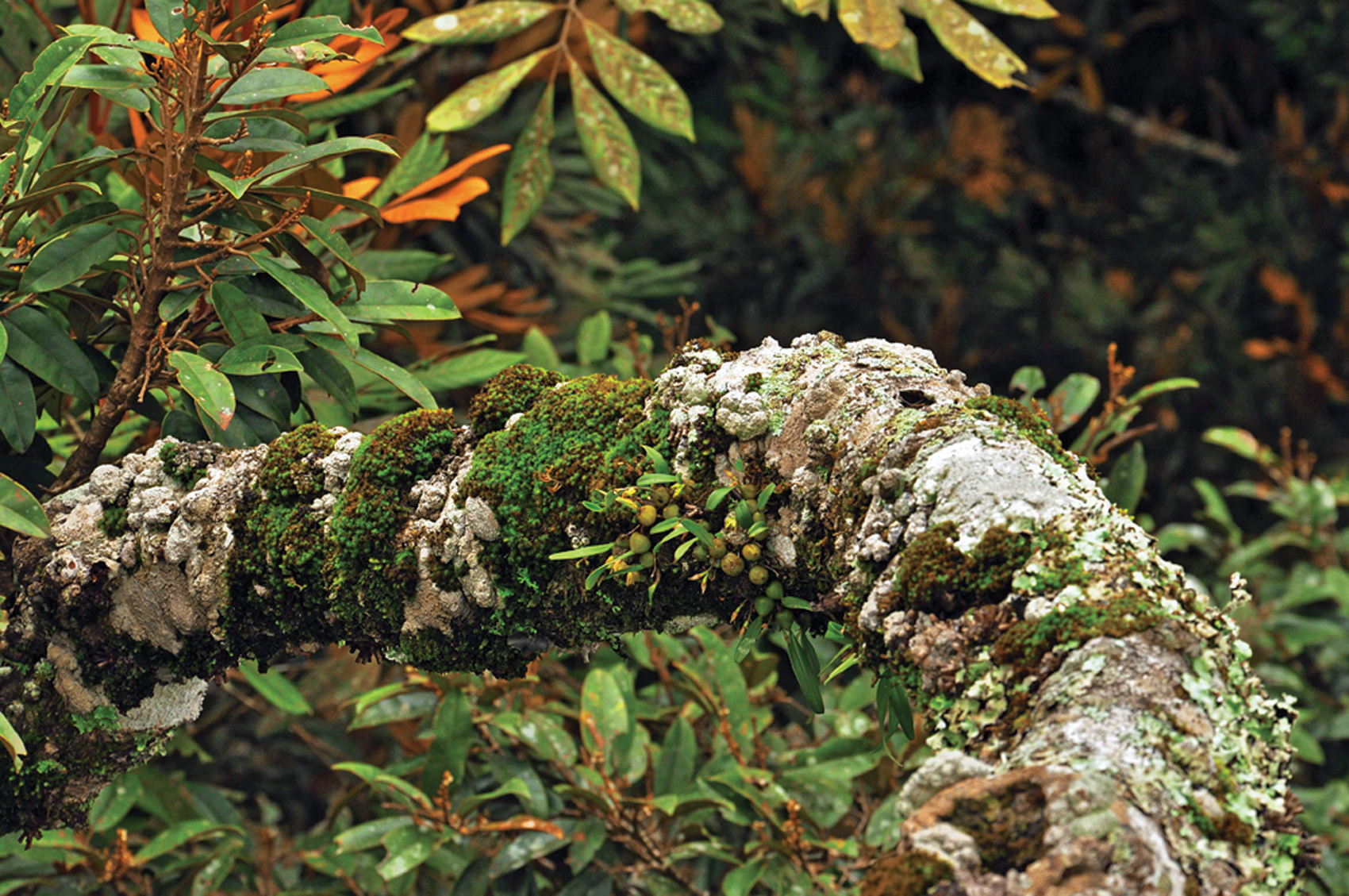
Beautiful, non-parasitic plants that germinate and grow on other plants, epiphytes are a crucial component of the forest canopy ecology. Over 31,000 species of epiphytes are known globally and comprise nearly 10 per cent of plant diversity. Photo: Dr. Seshadri K.S.
One host tree species, Cullenia exarillata, hosted the highest number of epiphyte species as well as individuals in both logged and unlogged forests. While other trees also hosted epiphytes, C. exarillata was likely most suitable for germination owing to its commonness, large size, muddy bark as well as knobby branches created by inflorescence. Among the epiphytes encountered, one species of orchid, Eria pauciflora was the most abundant in both logged and unlogged sites. The plant grows as a dense cluster. Each plant is a pair of leaves and a bulb, attached to a long stalk. Starting in April, a pair of white flowers emerge from each stalk. This species was often encountered toward the tree trunk and not at its extremities. Other epiphytes such as Papillionanthe subulata were often found on the outermost tree branches. They lack a leaf-like structure but appear as a hard, chlorophyll-laden cluster of twigs. The flowers, however, are large and colourful. Despite being common, little else is known about these plants.
Although we found a greater abundance of epiphytes in the logged site, the niche overlap of each epiphyte species based on their host tree was greater in the selectively logged site. It was evident that the epiphyte community had been altered and appeared to jostle for space in the selectively logged forest. The tree branches here may have been a limiting resource. One way to examine if spore arrival is greater in selectively logged sites is to experiment by artificially preventing epiphytes from colonising one branch while estimating colonisation rates in the other.
Finally, we examined if the host tree itself influences the presence of epiphytes. Indeed, the unlogged forest negatively influenced the epiphytes whereas the tree height and canopy spread were positively associated with an abundance of epiphytes. We suspect that the contiguous canopy in the unlogged forest greatly regulates the light, humidity, and temperature profiles, thus stabilising the epiphyte community. In the logged forest, increased sunlight may facilitate the growth of epiphytes but has consequences on the tree. For instance, do branches loaded with epiphytes break more frequently in the selectively logged forest? Unfortunately, only a handful of researchers have ever dared to venture into the canopy of our Western Ghats,and we do not yet have answers to several such questions.
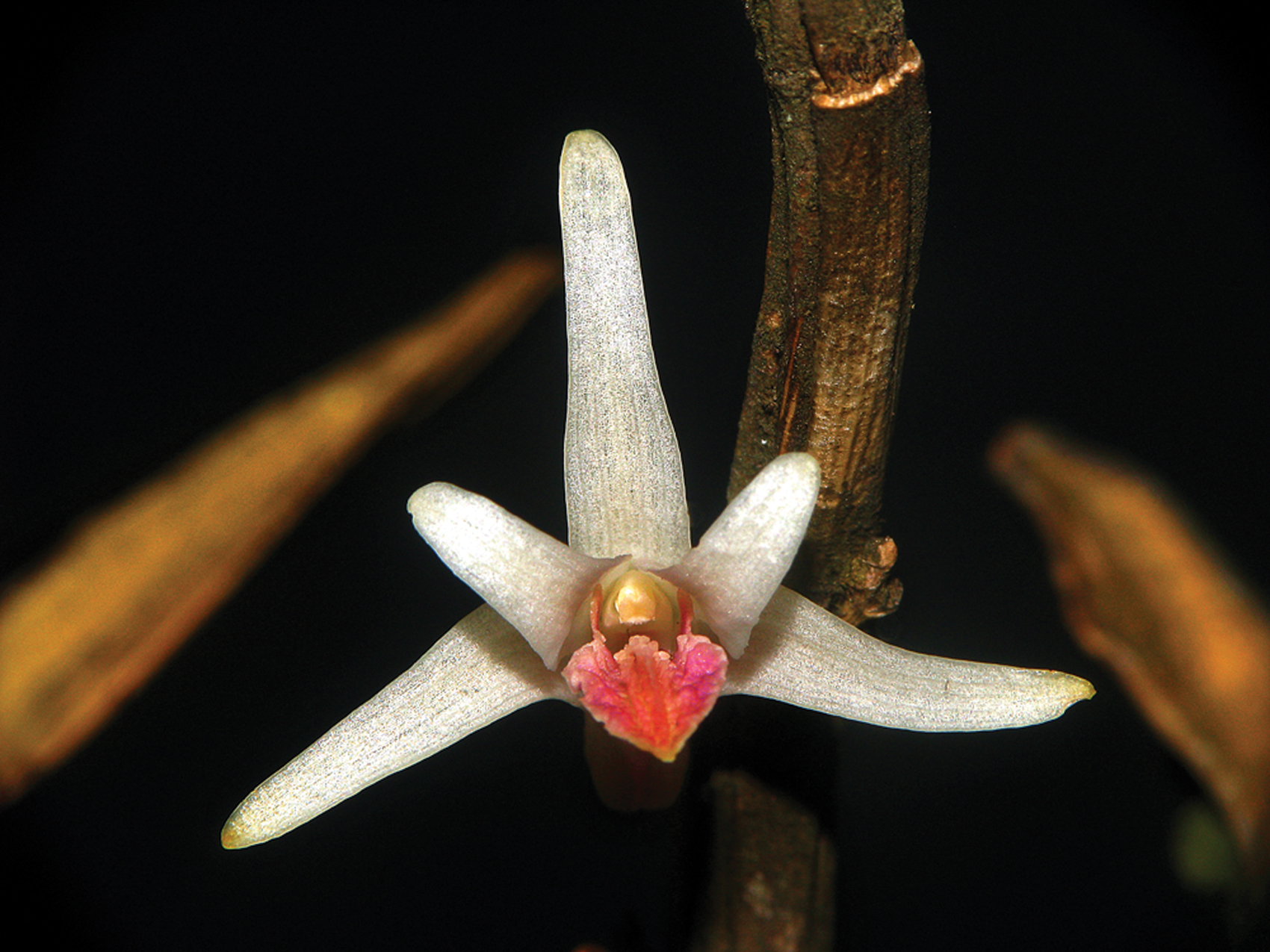
An orchid belonging to the Denderobium genus, which includes more than 1,800 species found mostly in South, East and Southeast Asia. Photo: Dr. Seshadri K.S.
A Leaky Roof
Forest canopies are a delight to a botanist wanting to study plants. They offer a fascinating laboratory for ecologists attempting to fathom the intricate connections between different components of the vast ecosystem. Slight perturbations to the forest can leave profound results on a seemingly distant component of the ecosystem. The impacts of selectively logging trees in KMTR appear to persist even after 40 years of recovery. Recent assessments in KMTR show that the tree compositions remain changed in logged sites and anurans and butterflies occur in lower abundance in the logged forests. When we examine the epiphyte community, we find an opposite pattern of greater abundance and this should not be used as an excuse to continue logging. We suspect that the increased epiphyte abundance might be temporary and only long-term monitoring can inform us about the trajectory of recovery. We need to think of establishing a canopy crane to monitor a much wider area of the forest or establish permanent walkways to ease access to researchers.
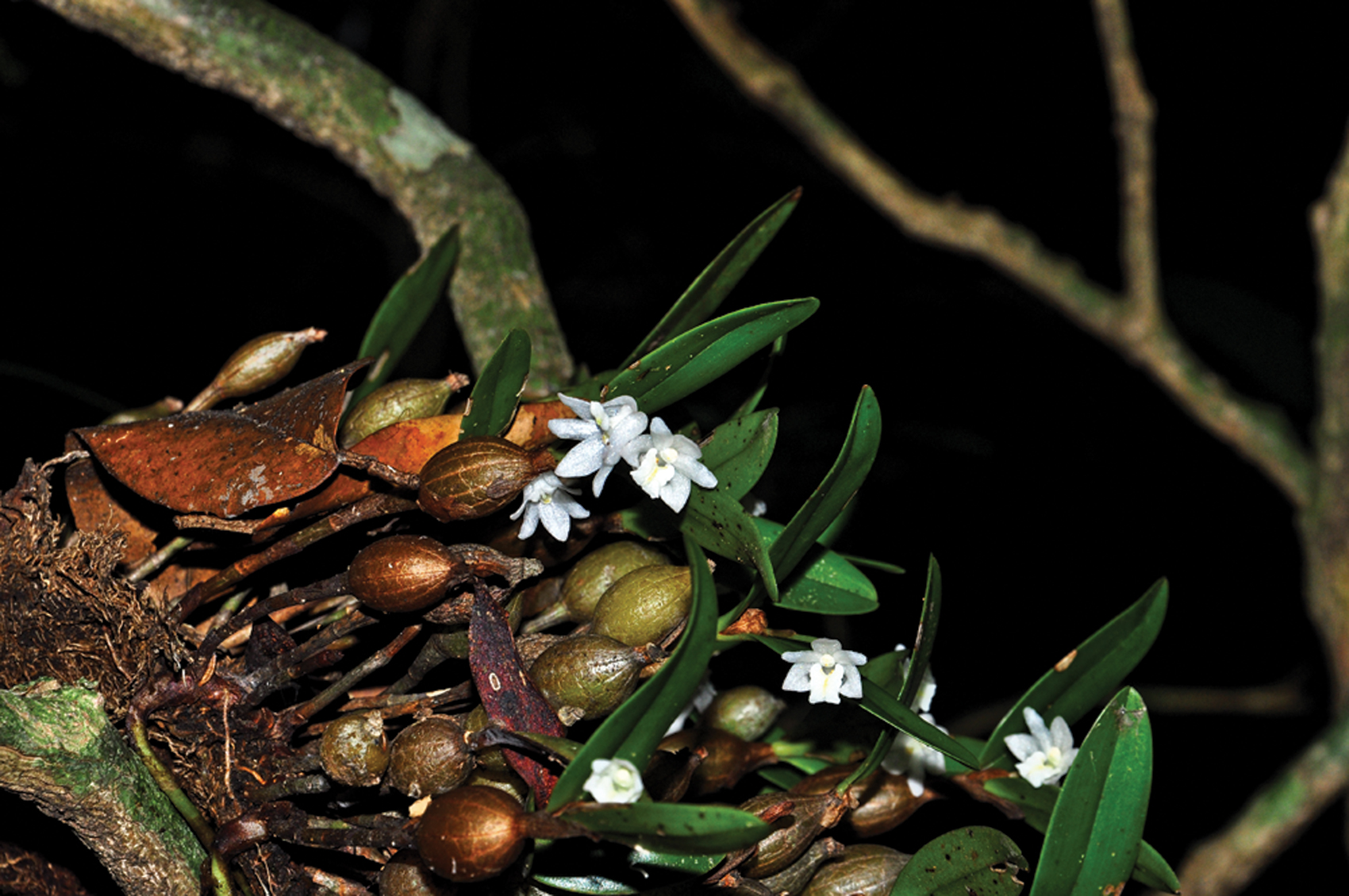
Eria pauciflora is an orchid species endemic to the Southwestern Ghats. The flowers are translucent, white and delicate. Photo: Dr. Seshadri K.S.
Climate change is another emerging threat to canopy life. It is widely observed that species respond to a changing climate by shifting their distribution to higher elevations or latitudes, which are inherently cooler. For a species growing exclusively in the canopy, this is impossible. There is nowhere further to go. Epiphytes are also often ignored in vegetation assessments, with much attention being given to trees. By mistaking the trees for the forest, we would be losing out on an opportunity to know the intricacies of the forest canopy. Our policies on forest management and strategies to cope with climate change must also include the canopy perspective.
It is perhaps time for us to rekindle the ape in all of us and swing from the treetops to learn and work towards protecting this unique component of the ecosystem.
Dr. Seshadri K.S. An avid birdwatcher, he studies the evolutionary ecology of amphibians at the Centre for Ecological Sciences, Indian Institute of Science. He has discovered new amphibian behaviour as well as species.







